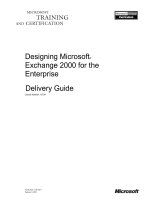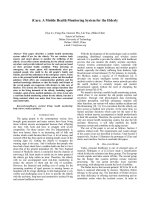Architecting Mobile Solutions for the Enterprise pptx
Bạn đang xem bản rút gọn của tài liệu. Xem và tải ngay bản đầy đủ của tài liệu tại đây (24.91 MB, 472 trang )
www.it-ebooks.info
www.it-ebooks.info
Architecting Mobile
Solutions for the
Enterprise
Dino Esposito
www.it-ebooks.info
Published with the authorization of Microsoft Corporation by:
O’Reilly Media, Inc.
1005 Gravenstein Highway North
Sebastopol, California 95472
Copyright © 2012 by Dino Esposito
All rights reserved. No part of the contents of this book may be reproduced or transmitted in any form or by any
means without the written permission of the publisher.
ISBN: 978-0-7356-6302-2
1 2 3 4 5 6 7 8 9 LSI 7 6 5 4 3 2
Printed and bound in the United States of America.
Microsoft Press books are available through booksellers and distributors worldwide. If you need support related
to this book, email Microsoft Press Book Support at Please tell us what you think of
this book at
Microsoft and the trademarks listed at />Trademarks/EN-US.aspx are trademarks of the Microsoft group of companies. All other marks are property of
their respective owners.
The example companies, organizations, products, domain names, email addresses, logos, people, places, and
events depicted herein are ctitious. No association with any real company, organization, product, domain name,
email address, logo, person, place, or event is intended or should be inferred.
This book expresses the author’s views and opinions. The information contained in this book is provided without
any express, statutory, or implied warranties. Neither the authors, O’Reilly Media, Inc., Microsoft Corporation,
nor its resellers, or distributors will be held liable for any damages caused or alleged to be caused either directly
or indirectly by this book.
Acquisitions and Developmental Editor: Russell Jones
Production Editor: Kristen Borg
Production Services: S4Carlisle Publishing Services
Technical Reviewer: Marco Bellinaso
Copyeditor: Sue McClung
Indexer: Margaret Troutman
Cover Design: Twist Creative • Seattle
Cover Composition: Karen Montgomery
Illustrator: S4Carlisle Publishing Services
www.it-ebooks.info
To Silvia, because you’re stronger than you think.
To Michela, because you’re just the daughter I always dreamt of.
To Francesco, because you’re a terric, quick learner.
—Dino
www.it-ebooks.info
www.it-ebooks.info
Contents at a Glance
Introduction xiii
PART I GOING MOBILE
CHAPTER 1 Pillars of a Mobile Strategy 3
CHAPTER 2 Mobile Sites vs. Native Applications 25
PART II MOBILE SITES
CHAPTER 3 Mobile Architecture 43
CHAPTER 4 Building Mobile Websites 63
CHAPTER 5 HTML5 and jQuery Mobile 105
CHAPTER 6 Developing Responsive Mobile Sites 137
PART III MOBILE APPLICATIONS
CHAPTER 7 Patterns of Mobile Application Development 173
CHAPTER 8 Developing for iOS 207
CHAPTER 9 Developing for Android 267
CHAPTER 10 Developing for Windows Phone 323
CHAPTER 11 Developing with PhoneGap 381
Index 417
www.it-ebooks.info
www.it-ebooks.info
vii
What do you think of this book? We want to hear from you!
Microsoft is interested in hearing your feedback so we can continually improve our
books and learning resources for you. To participate in a brief online survey, please visit:
www.microsoft.com/learning/booksurvey/
Contents
Introduction xiii
PART I GOING MOBILE
Chapter 1 Pillars of a Mobile Strategy 3
What Does “Going Mobile” Mean? 4
Toward a Mobile Strategy 4
Dening a Mobile Strategy 7
Development and Costs 10
Outlining a B2C Strategy 13
Focus on Your Audience 13
Delivery Models 16
Outlining a B2B Strategy 19
Serve Your (Limited) Audience 19
Mobile Enterprise Application Platforms 21
Summary. . . . . . . . . . . . . . . . . . . . . . . . . . . . . . . . . . . . . . . . . . . . . . . . . . . . . . . . 23
Chapter 2 Mobile Sites vs. Native Applications 25
Not a Pointless Matter 26
A False Dilemma—but True Differences 26
Reasons for the Perceived Dilemma 31
Aspects of Mobile Sites 33
What’s Good About Mobile Sites 33
What’s Bad About Mobile Sites 34
www.it-ebooks.info
viii
Contents
Aspects of Native Applications 37
What’s Good About Native Applications 37
What’s Bad About Native Applications 38
Summary. . . . . . . . . . . . . . . . . . . . . . . . . . . . . . . . . . . . . . . . . . . . . . . . . . . . . . . . 40
PART II MOBILE SITES
Chapter 3 Mobile Architecture 43
Focusing on Mobile Use-Cases 44
Stereotypes to Refresh 44
Analysis First 46
Mobile-Specic Development Issues 51
Toward a Mobile Application Layer 51
Server-Side Device Detection 57
Summary. . . . . . . . . . . . . . . . . . . . . . . . . . . . . . . . . . . . . . . . . . . . . . . . . . . . . . . . 61
Chapter 4 Building Mobile Websites 63
From Web to Mobile 64
Application Structure 64
Amount of JavaScript 67
Application Device Proles 69
Optimizing the Payload 71
The Ofine Scenario 75
Development Aspects of a Mobile Site 76
Reaching the Mobile Site 76
Design of the Mobile Views 82
Testing the Mobile Site 88
The Device-Detector Site 90
Routing to Mobile Views 91
Detecting Device Capabilities 93
Putting the Site Up 98
Summary. . . . . . . . . . . . . . . . . . . . . . . . . . . . . . . . . . . . . . . . . . . . . . . . . . . . . . . 104
www.it-ebooks.info
ix
Contents
Chapter 5 HTML5 and jQuery Mobile 105
jQuery Mobile Fast Facts 106
Generalities of jQuery Mobile 106
Building Mobile Pages with jQuery Mobile 109
Working with Pages 117
HTML5 Fast Facts 121
Semantic Markup 122
Web Forms and Data Entry 126
Programmer-Friendly Features 130
Using HTML5 Today 134
Summary. . . . . . . . . . . . . . . . . . . . . . . . . . . . . . . . . . . . . . . . . . . . . . . . . . . . . . . 136
Chapter 6 Developing Responsive Mobile Sites 137
A Developer’s Perspective of Device Detection 138
The Client-Side Route 138
The Server-Side Route 142
Inside WURFL 144
Structure of the Repository 144
Top 20 WURFL Capabilities 148
Using WURFL from ASP.NET 153
Implementing a Multiserving Approach 158
Key Aspects of Mobile Views 159
Creating Device Proles 160
Device Proles in Action 161
Summary. . . . . . . . . . . . . . . . . . . . . . . . . . . . . . . . . . . . . . . . . . . . . . . . . . . . . . . 169
PART III MOBILE APPLICATIONS
Chapter 7 Patterns of Mobile Application Development 173
Mobile Applications Are Different 174
Critical Aspects of Mobile Software 174
New Patterns and Practices 176
www.it-ebooks.info
x
Contents
Patterns for Interaction 179
The Back-and-Save Pattern 179
The Guess-Don’t-Ask Pattern 182
The A-la-Carte-Menu Pattern 185
The Sink-or-Async Pattern 186
The Logon-and-Forget Pattern 189
Patterns for Presentation 191
The Babel-Tower Pattern 191
The Do-as-Romans-Do Pattern 195
The List-and-Scroll Pattern 196
Behavioral Patterns 199
The Predictive Fetch Pattern 199
The Memento-Mori Pattern 200
The As-Soon-As-Possible Pattern 202
Summary. . . . . . . . . . . . . . . . . . . . . . . . . . . . . . . . . . . . . . . . . . . . . . . . . . . . . . . 205
Chapter 8 Developing for iOS 207
Getting Ready for iOS Development 208
A Brand New Platform for (So Many) Developers 208
Choosing the Development Strategy 212
Programming with Objective-C 215
A Quick Look at Objective-C 215
The HelloWorld Program 224
Examining a Sample Application 231
Other Programming Topics 243
Programming with MonoTouch 246
The .NET Framework on iOS 247
Examining a Sample Application 251
Deploying iOS Applications 259
Testing the Application 259
Distributing the Application 263
Summary. . . . . . . . . . . . . . . . . . . . . . . . . . . . . . . . . . . . . . . . . . . . . . . . . . . . . . . 265
www.it-ebooks.info
xi
Contents
Chapter 9 Developing for Android 267
Getting Ready for Android Development 268
Development Tools and Challenges 268
Choosing the Development Strategy 270
The Android Jungle 275
Programming with the Android SDK 278
Anatomy of an Application 278
Dening the User Interface 285
Examining a Sample Application 294
Other Programming Topics 308
Testing the Application 318
Distributing the Application 320
Summary. . . . . . . . . . . . . . . . . . . . . . . . . . . . . . . . . . . . . . . . . . . . . . . . . . . . . . . 321
Chapter 10 Developing for Windows Phone 323
Getting Ready for Windows Phone Development 324
Development Tools and Challenges 324
Choosing the Development Strategy 326
Programming with the Silverlight Framework 329
Anatomy of an Application 329
Dening the User Interface 337
The MVVM Pattern 348
Examining a Sample Application 353
Other Programming Topics 366
Deploying Windows Phone Applications 375
Testing the Application 375
Distributing the Application 378
Summary. . . . . . . . . . . . . . . . . . . . . . . . . . . . . . . . . . . . . . . . . . . . . . . . . . . . . . . 379
Chapter 11 Developing with PhoneGap 381
The Myth of Cross-Platform Development 382
The Virtual Machine Approach 383
The Shell Approach 386
www.it-ebooks.info
xii
Contents
Building an HTML5 Solution 392
JavaScript Ad Hoc Patterns 392
The Sample Application 398
Integrating with PhoneGap 405
Supported Platforms 405
Building a PhoneGap Project 406
Final Considerations 412
Summary. . . . . . . . . . . . . . . . . . . . . . . . . . . . . . . . . . . . . . . . . . . . . . . . . . . . . . . 414
Index 417
www.it-ebooks.info
xiii
Introduction
A
s far back as 1999, some smart guys predicted that mobile would become the
primary focus of development in only a few years. Although it has taken a bit more
time than expected, the era of mobile software has arrived at last. Why did it take so
long? The answer is surprisingly simple: mobile software needed a critical mass of users
to develop before it could take off. The process of accumulating mobile users probably
started with the release of the rst iPhone back in 2007, but today, it has reached a
large enough mass to trigger all sorts of chain reactions.
Back in 1990 (yes, you read that right), Bill Gates gave a keynote talk at Comdex
titled “Information at Your Fingertips.” Let’s be honest—for 20 years, we pretended
we really had information (that we needed) at our ngertips, but at most, we had that
information only at hand—which makes a huge difference. Now is the time, though,
that we can cover the short distance from hand to ngertips. With mobile devices
everywhere, and especially with a revolutionary version of Windows on the horizon,
I believe we’re truly entering a new era of development—a paradigm shift.
Paradigm shifts just happen—and mobile represents a big one. Mobile enables new
business scenarios and new ways of doing the same business. Mobile affects nearly
everybody—users, professionals, and clearly developers. Writing mobile applications
is a challenge that the vast majority of developers will face in the near future. Overall,
mobile applications are simpler than desktop or web applications—but that’s true only
if you count just the number of functions. The hardest part of mobile development is to
identify the right set of use-cases and the right user experience and interaction model.
It turns out that the typical mobile application user is much less forgiving than the
average user of web or desktop applications. As developers, we forced users to play by
the rules of software for decades. In contrast, mobile developers will be forced to play
by the rules of user experience and conform to user expectations. This is how software
always should have been; but it’s denitely not how software has been built for at least
the past 20 years. Moreover, before too many more years pass, mobile may well be the
only software that we will be called upon to write.
The term mobile refers to a variety of platforms, each with its own set of capabilities and
features, and each of which requires signicantly different skills: different operating systems,
different programming languages, different application programming interfaces (APIs), and
even different computers. A mobile application is more sophisticated and more complex
than web applications with regard to resource management, data entry, sensors, data
storage, and life cycle. Furthermore, each operating system has its own set of development
guidelines and a proprietary deployment model.
www.it-ebooks.info
xiv Introduction
This book is intended as a quick-but-juicy guide to issues that you may face while
developing a mobile project for one or multiple platforms. The book starts by analyzing
the various types of mobile solutions, which include websites, websites optimized
for mobile devices, and native mobile applications, and then identies a few design
patterns common to all mobile applications and technologies available on the various
platforms. Predictive fetch, back-and-save, and guess-don’t-ask are just a few of the
patterns being discussed and implemented. The book puts considerable emphasis
on mobile sites and frameworks, and on techniques to detect browser capabilities
accurately. For example, the book offers a chapter on Wireless Universal Resource FiLe
(WURFL)—the framework being used by Facebook for mobile device detection—and
compares that to the detection capabilities in plain ASP.NET.
Furthermore, the book offers an overview of mobile development for the three
major platforms—iOS, Android, and Windows Phone. In particular, this book builds
the same application for all three platforms, discussing tools, frameworks, practices,
and illustrating architectural and structural differences along the way. Finally, the book
covers PhoneGap and HTML5-based development for mobile devices.
After reading this book, you probably won’t be a super-expert in any of those
platforms, but you’ll know enough to start producing code on any of the most popular
devices. You’ll also know enough to advise your customers and help them dene
effective mobile strategies for their business.
Who Should Read This Book
As companies start going mobile, they need a strategy long before they need a mobile
site or an iPhone app. But when companies have developed the strategy and start look-
ing into implementing it, they face the rough issue of not having or nding architects
and developers that know the mobile world from a variety of angles. Today, they can
easily nd great iPhone or Android developers, but they can hardly nd a consultant
that can suggest, based on strong evidence, whether a mobile site is preferable for
them.
This book is aimed at providing an architect summary of what you need to know
to design and implement mobile solutions. Today, a mobile solution often means
arranging the same application for several different platforms (iPhone, Android,
Blackberry, and Windows Phone), and doing that using a very specic set of design
patterns with little in common with desktop or web apps. Last but not least, the effort
must be done in the context of the customer’s needs, expectations, and existing
business.
www.it-ebooks.info
Introduction xv
Not a Mobile Developer? Not a Developer!
For a company with a consolidated business, mobile is a way to expand its horizon. The new
expansion stage of mobile is reaching out to companies and enterprises and prospecting
new ways of doing business. This is a paradigm shift with a deep impact that will give rise to
new professional jobs, much as the web itself did more than a decade ago.
That’s why I maintain that in only a couple of years, every developer will be either a
mobile developer or no developer at all. Being a mobile developer surely includes knowing
iOS, Windows Phone, HTML5, and Android, and perhaps BlackBerry, possibly Bada, and
even developing for smart TVs—and, of course, for the mobile web. More than anything
else, though, developers must acquire a “mobile mindset.” You can always gure out fairly
easily how to play a video on iOS, or how to make an Android device vibrate. But what isn’t
as easy to acquire is the intrinsic nature of mobile applications and the patterns behind
them, and which aspects to focus on for optimization.
Mobile is different. Overall, it’s simpler, but it’s also much less forgiving than other
types of applications.
Therefore, this book is for everybody who needs to acquire some mobile
development insight. The book’s contents won’t become obsolete in just a few months
because I made a serious attempt to reach and report from the heart of the mobile
experience. This book discusses technology, but it is not based on any particular
technology; therefore, it’s an introductory text for any form of mobile development.
Who Should Not Read This Book
This book won’t make you a top-notch iPhone or Android developer; it’s intended to
help everybody (including those of you who are already top-notch iPhone or Android
developers) understand the entire mobile world. The goal is to get readers prepared
for architecting effective mobile solutions after a mobile plan has been nalized and
accepted. If you’re looking for detailed, step-by-step examples of how to play an
animation, make the phone vibrate, or making an Internet call on all possible platforms,
you won’t usually nd them here. But I hope that you will nd enough to help you get
started with every aspect of mobile development.
www.it-ebooks.info
xvi Introduction
Organization of This Book
This book is divided into three sections. Part I, “Going Mobile,” is about the possible
strategies to approach the mobile world. Part II, “Mobile Sites,” covers the architecture
and implementation of mobile sites and also touches on HTML5 and jQuery Mobile.
Part III, “Mobile Applications,” is about the three major mobile platforms of today—
iOS, Android, and Windows Phone—and also covers PhoneGap as a way of unifying
development in a single codebase.
Finding Your Best Starting Point in This Book
The different sections of Architecting Mobile Solutions for the Enterprise cover a wide
range of technologies associated with mobile development. Depending on your needs
and your existing understanding of mobile, you may wish to focus on specic areas of
the book. Use the following table to determine how best to proceed through the book.
If you are Follow these steps
New to mobile and spent your entire
career doing other software-related
work
Read the chapters as they are laid out in the book.
A web developer looking into how
to build mobile sites
Focus primarily on Part II.
A chief technology ofcer (CTO) or
chief architect
Focus on Part I rst, and then move to Part II and/or Part III,
depending on whether mobile sites or mobile apps are more
likely to be relevant in your context. But read the entire book
anyway.
Familiar with mobile app
development in one (or more)
platforms
You might want to start with the chapters that cover topics
that you are familiar with. These chapters are essential guides,
so it is likely that you won’t learn anything new there. But
if you nd that you miss some of the points discussed, then
you’ve got something already from the book. Next, I suggest
you focus on Chapter 7, “Patterns of Mobile Application
Development,” and Chapter 11, “Developing with PhoneGap.”
Note This table simply attempts to provide some guidance on how to learn
best from this book. In any case, I heartily recommend that you read all the
chapters thoroughly.
www.it-ebooks.info
Introduction xvii
Conventions and Features in This Book
This book presents information using conventions designed to make the information
readable and easy to follow.
Boxed elements with labels such as “Note” provide additional information or
alternative methods for completing a step successfully.
Text that you type (apart from code blocks) appears in bold.
A plus sign (+) between two key names means that you must press those keys at
the same time. For example, “Press Alt+Tab” means that you hold down the Alt
key while you press the Tab key.
System Requirements
You will need the following hardware and software to set yourself up for development on
the various mobile platforms and compile the sample code that accompanies this book:
For iOS, you need a Mac computer with Xcode and the latest iOS software
development kit (SDK). If you plan to use MonoTouch, then you also need to get
at least a trial version of the product from . Note that
to deploy applications on a iOS device, you also need to be a registered Apple
developer enrolled in one of the Apple pay programs.
For Android, you can use a Windows PC, preferably equipped with Windows 7.
Note, however, that you can do Android development from a Mac or Linux PC
as well. You can use Eclipse or the IntelliJ IDEA as your integrated development
environment (IDE). You will need the Java SDK and the Android SDK installed.
You don’t need to be a registered developer to compile and deploy Android
applications on a device.
For Windows Phone, you need Microsoft Visual Studio Express for Windows
Phone, as well as a Windows PC.
Code Samples
This book comes with a few examples organized as follows:
Two ASP.NET websites congured to use WURFL
www.it-ebooks.info
xviii Introduction
The Guess application for iOS
The Guess application for Android
The Guess application for Windows Phone
The HTML5 Guess application for PhoneGap
The sample code contains les that you can incorporate in your own projects using
the tools that you prefer.
Many of the chapters in this book include examples that let you try out new material
discussed in the main text. You can download all the sample projects from the following
page:
/>Follow the instructions to download the Amse.zip le.
Note In addition to the code samples, your system should have Visual Studio
2010 and Microsoft SQL Server 2008 installed. The instructions that follow
use SQL Server Management Studio 2008 to set up the sample database used
with the practice examples. If available, install the latest service packs for each
product.
Installing the Code Samples
Follow these steps to install the code samples on your computer so that you can use
them with the exercises in this book:
1. Unzip the Amse.zip le that you downloaded from the book’s website (name a
specic directory, along with directions to create it, if necessary).
2. If prompted, review the displayed End User License Agreement (EULA). If you
accept the terms, select the Accept option, and then click Next.
Note If the license agreement doesn’t appear, you can access it from
the same webpage from which you downloaded the Amse.zip le.
www.it-ebooks.info
Introduction xix
Acknowledgments
It took me several months of deep dive to make sense of the many facets of mobile: the
customer’s angle, the developer’s perspective, the architect’s vision, and the myriads of
devices, operating systems, SDKs, and products. Many friends helped me out along the way.
First and foremost, I want to thank Marco Bellinaso of Mopapp, who rst introduced
me to the world of mobile apps and then served as an invaluable technical editor for
this book. Marco also tried to make me a fan of Objective-C, but I’m afraid his efforts
failed in that regard.
Devon Musgrave of Microsoft Press and Russell Jones of O’Reilly believed in this
book and made it happen, along with Kristen Borg and the other members of the
editing team.
I was surprised to see how many friends asked to review chapters and enthusiastically
shared their feedback. I could see an underlying passion and pleasure in their work and
I’m not sure my monumental THANK YOU here is enough. In particular, I wish to thank
Luca Passani of ScientiaMobile. I met Luca at a web conference in London in 1999, where
he tried to sell me mobile as a hot business even back then. It took a bit more time, but his
vision was denitely right. I really enjoyed the feedback about mobile site development and
HTML5 that I got from Jon Arne Saeteras of MobileTech and Daniele Bochicchio of 5DLabs.
IT and Microsoft Regional Director for Italy. The chapters on mobile apps and PhoneGap
beneted from the feedback of many people, including Davide Zordan, Ugo Lattanzi, Leon
Zandman, Catalin Georghiu, and Davide Senatore. All these people shared their real-world
experience with me concerning Windows Phone and PhoneGap.
Near-nal thanks go to my team at Crionet and E-tennis.net. As I write these
notes, we are nalizing the mobile apps for the worldwide audience of tennis fans
following the Rome ATP Masters 1000 tournament. It’s the rst tournament to offer
a comprehensive mobile, web, and social experience and the rst one to offer mobile
apps on a full range of platforms, including not just iOS and Android, but also Windows
Phone and BlackBerry. Working with you guys is a privilege.
What else? Well, just a nal note. Take note of this name: Francesco Esposito. I’m
sure you’ll hear this name in the future. He’s 14 and he’s already an all-round mobile
developer. My use of the word developer is no accident, because that’s what he is,
irrespective of schooling and age. In his way of coding, learning, thinking, and speaking,
I see crystal-clear talent. Being his dad, well, I feel proud.
www.it-ebooks.info
xx Introduction
Errata & Book Support
We’ve made every effort to ensure the accuracy of this book and its companion
content. Any errors that have been reported since this book was published are listed on
our Microsoft Press site at oreilly.com:
/>If you nd an error that is not already listed, you can report it to us through the
same page.
If you need additional support, email Microsoft Press Book Support at mspinput@
microsoft.com.
Please note that product support for Microsoft software is not offered through the
addresses above.
We Want to Hear from You
At Microsoft Press, your satisfaction is our top priority, and your feedback our most
valuable asset. Please tell us what you think of this book at:
/>The survey is short, and we read every one of your comments and ideas. Thanks in
advance for your input!
Stay in Touch
Let’s keep the conversation going! We’re on Twitter: />www.it-ebooks.info
1
Part I
Going Mobile
CHAPTER 1 Pillars of a Mobile Strategy 3
CHAPTER 2 Mobile Sites vs. Native Applications 25
www.it-ebooks.info
www.it-ebooks.info
3
CHAPTER 1
Pillars of a Mobile Strategy
In preparing for battle, I have always found that plans are useless, but planning is
indispensable.
—Dwight D. Eisenhower
In this chapter:
What Does “Going Mobile” Mean?
Outlining a B2C Strategy
Outlining a B2B Strategy
Summary
T
he modern era of mobile technology began with the release of the rst Apple iPhone in the
summer of 2007.
The mobile conquest of the world has been a “soon-to-be” matter for quite some time in the past
decade. I still remember the rst-ever mobile-related conference being held in Amsterdam in the
summer of 2000—the Wrox Wireless Developer Conference. I was a speaker there, and the implicit
message for attendees was “Mobile development is here—hurry up.”
There was no hurry, actually.
Only a couple of years later, Microsoft released ASP.NET with its own set of mobile controls for
optimized mobile websites. Later, mobile frameworks such as Microsoft .NET Compact Framework
and Java Micro Edition (J2ME) appeared; meanwhile, richer native operating systems such as Symbian
also appeared. However, the mobile conquest of the world never happened—and perhaps hadn’t
even begun—which begs the question: Why not?
The main reason is that the technology never reached a critical mass of users, and without that,
developers and software houses had no good reason to address the mobile space. But when the
Apple iPhone appeared, everything changed. Although the iPhone was not an entirely new idea, it
was an extremely well-done implementation. And, more importantly, a lot of people (on the order of
millions) liked it. That immediately created a breeding ground for new applications and gave mobile
technology a new form and immediacy.
www.it-ebooks.info









